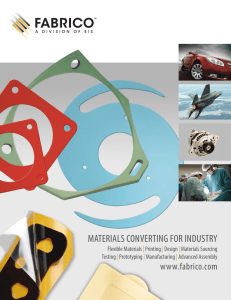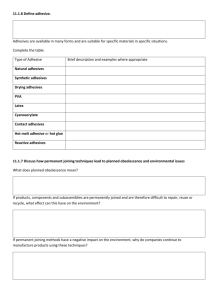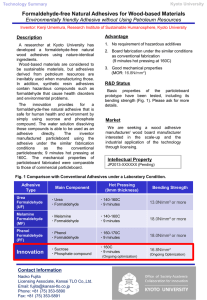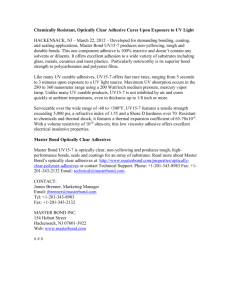New Uses of Adhesives in Durable Medical Diagnostic Equipment medical diagnostic
advertisement
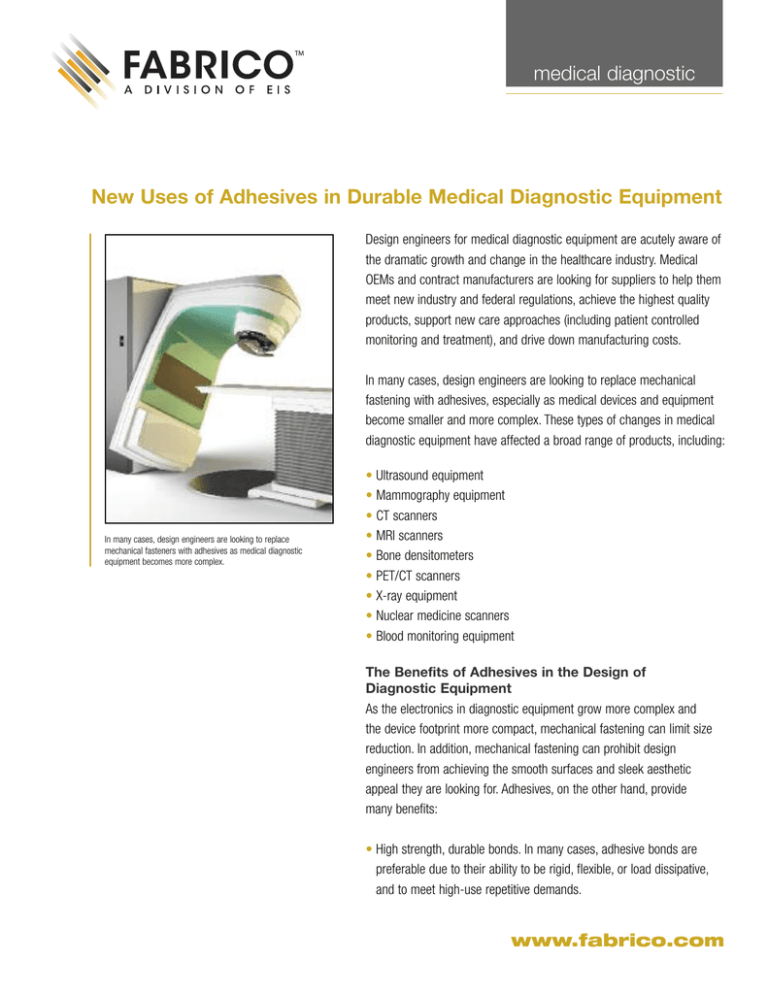
medical diagnostic New Uses of Adhesives in Durable Medical Diagnostic Equipment Design engineers for medical diagnostic equipment are acutely aware of the dramatic growth and change in the healthcare industry. Medical OEMs and contract manufacturers are looking for suppliers to help them meet new industry and federal regulations, achieve the highest quality products, support new care approaches (including patient controlled monitoring and treatment), and drive down manufacturing costs. In many cases, design engineers are looking to replace mechanical fastening with adhesives, especially as medical devices and equipment become smaller and more complex. These types of changes in medical diagnostic equipment have affected a broad range of products, including: In many cases, design engineers are looking to replace mechanical fasteners with adhesives as medical diagnostic equipment becomes more complex. • Ultrasound equipment • Mammography equipment • CT scanners • MRI scanners • Bone densitometers • PET/CT scanners • X-ray equipment • Nuclear medicine scanners • Blood monitoring equipment The Benefits of Adhesives in the Design of Diagnostic Equipment As the electronics in diagnostic equipment grow more complex and the device footprint more compact, mechanical fastening can limit size reduction. In addition, mechanical fastening can prohibit design engineers from achieving the smooth surfaces and sleek aesthetic appeal they are looking for. Adhesives, on the other hand, provide many benefits: • High strength, durable bonds. In many cases, adhesive bonds are preferable due to their ability to be rigid, flexible, or load dissipative, and to meet high-use repetitive demands. www.fabrico.com • Invisible joints. By eliminating screws, rivets, and welds, the medical product not only looks better, it also weighs less, and can be easier to clean. • Stress, fatigue relief. Adhesives distribute stress evenly across the bond line, eliminating stress fractures in plastics, composites, and other materials. The viscoelasticity of adhesives allows bond lines to resist fatigue, as well as shock and vibration. This results in quieter operation and a longer lasting unit. • More material options. Adhesives provide design engineers with greater freedom by eliminating the worries of joining different/dissimilar materials. • Air- and water-tight seals. Perfect for equipment used in harsh environments or subject to sterilization, adhesives can extend the work life and improve quality and durability. Picking the right adhesive reduces manufacturing cost through reduction in materials, weight, and the time spent drilling, screwing, and welding parts together. Adhesives for Diagnostic Equipment The primary types of adhesives used in diagnostic device applications include: • Epoxies • Acrylics • Urethanes • Acrylic pressure-sensitive adhesive (PSA) tapes • Adhesive transfer tapes These adhesives may be certified to comply with ISO 10993 or are USP Class VI approved. They may also be formulated for bio-compatibility and sterilization as required. Epoxies are used extensively, as liquids and as films that can be die-cut to intricate custom shapes. Epoxy bonding systems are a good choice when the bond line geometry presents a gap that must be filled. Epoxies are well-suited for rigid structural bonds and are available in formulations for: Acrylic and acrylic foam tapes and films can be die-cut and used to replace rivets and screws in medical diagnostic equipment. • Instant bonding epoxy for most plastics, rubbers, and metals, including low surface energy (LSE) plastics; • UV cured structural epoxy for bonding glass, most plastics, and metals with high temperature resistance; • Structural adhesives for metal, plastics, and rubber with durable adhesion, flexibility, heat resistance, and void-filling. Fast curing acrylics are available as one-part anaerobic adhesives that cure in the absence of oxygen, one-part light-cure adhesives that set up in seconds, and two-part formulations with improved viscosity and handling characteristics. Cyanoacrylates are also popular; they include one-part formulations that cure within seconds and are well-suited for joining materials that are difficult to bond, including polypropylene and polyethylene. These adhesives are ideal for joining plastics such as ABS, PVC, latex, polycarbonate, styrene, acrylic, and thermoset plastic. Urethanes are available in one- and two-part formulations and form uniquely tough but flexible bonds. Urethane adhesives are often selected for their enhanced chemical and thermal properties. This makes urethanes suitable for reusable equipment that undergoes repeat sterilization. Urethanes are not suitable for high moisture environments. Acrylic and acrylic foam tapes bond on contact with no fixturing,and absorb shock and vibration. They are a good replacement for rivets and screws for invisible fastening to permanently bond many materials seamlessly, whether they are flat or curved.Design engineers love acrylic tapes because these pressure sensitive adhesives can be die-cut to any size or complex shape. Adhesive transfer tapes are PSAs backed with a release liner. Available in rolls for easy handling, these tapes require no drying time or adhesive clean-up. They are a good choice for attaching faceplates, nameplates, or panels to LSE substrates and powder-coated, enamel paint surfaces, plasticized vinyl, or even silicone.Selecting the best attachment method for a particular application often requires testing and consideration of the production process – whether the process will be manual or automated. Medical Diagnostic Equipment Applications Adhesives provide design engineers with greater latitude in every aspect of diagnostic equipment development from electronic components to equipment faceplates and panels. Adhesive applications include: • Electrical and electronics: electrical insulation and conductivity, thermal management, EMI/EMC shielding; • Bonding and sealing components: equipment panels, handheld monitors, LCDs; • Attaching components: membrane switches, control consoles, remote controls; • Bonding subassemblies: blood transducers, endoscopes, surgical and orthopedic tools (including handheld tools); • Gasketing and sealing: air- and water-tight connections. The Role of the Converter The importance of working with an experienced converter in the medical device industry can’t be overstated, especially to take advantage of advanced adhesive capabilities. Converters, such as Fabrico, deliver a range of die-cutting capabilities, advice in selecting the most appropriate materials, and the ability to identify the best adhesive for an application. As more medical devices are designed in a handheld configuration, selecting the right materials and adhesives combinations is critical. Fabrico helps medical OEMs and contract manufacturers from the initial design and development stages through production, assembly, and kitting. Fabrico has the materials and adhesive expertise to qualify materials based on: • Temperature resistance and performance at upper temperature limits; • Shear, tensile, and peel strength; • Electrical conductivity, dielectric strength, and outgassing; • Thermal conductivity and heat dissipation. As more medical diagnostic devices move to a handheld configuration, especially as ongoing monitoring and care responsibility is shifted from the physician/healthcare provider to the patient, and remote health monitoring becomes more popular, selecting the right material and adhesive combination becomes more important. For example, in a handheld diagnostic device with an LCD display, Fabrico provides expertise in many areas of design and manufacture: • Lens assembly, using high-performance die-cut tape for UV-coated surfaces; • Lens protection with die-cut protective tape; • LCD construction and shielding using optically-clear, die-cut polyester tape and acrylic tape to attach the LCD to the panel; • Die-cut foam gasketing with double-coated adhesive for high adhesion to LSE plastic surfaces. Fabrico’s capabilities include die-cutting, water jet cutting, slitting, and laminating for medical diagnostic components. Fabrico can select from servo driven rotary die-cutting, CNC die-cutting, laser die-cutting, and water jet die-cutting to meet the complex specifications of medical components. For complex foam tape die-cutting, water jet technology provides clean edges with no distortion. Laser die-cutting, kiss-cutting, slitting, and laminating can also be used in converting for medical applications. In many instances, Fabrico provides label printing for tamper evident and custom pressure-sensitive labeling of medical devices. Fabrico is also able to suggest the appropriate adhesive alternatives for a specific application, such as single- or double-coated tapes, the best liner for an application, whether a foam tape is well-suited for an application, and what might be available in hydrocolloid tape formulations. Material Partners Fabrico has strategic relationships with world-class materials suppliers, such as 3M, Loctite®, and Adhesives Research to assist its customers in selecting the best material for the intended use and to expedite materials sourcing. Whether adhesive films or liquids, all critical material properties are considered in every Fabrico project, including chemical, thermal, and moisture resistance. With more than 30 years of materials experience, Fabrico engineers also understand the impact of a material selection on the overall manufacturing process, and design material systems that optimize production efficiency and improve overall cost-effectiveness. Fabrico also provides a state-of-the-art test facility with the following capabilities: • Part dimension verification • Adhesive/release liner testing • Material strength testing • Static shear testing • Material weight measurement • Microscopic imaging • Electrical properties, including dielectric strength Fabrico Headquarters 4175 Royal Drive, Suite 800, Kennesaw, GA 30144 Phone: 678-202-2700 | Fax: 678-202-2702 Toll Free: 800-351-8273 | E-mail: info@fabrico.com www.fabrico.com Fabrico is a trademark of EIS, Inc.; 3M is a trademark of the 3M Company. Loctite is a Registered Trademark of Henkel AG & Co. KGaA.

